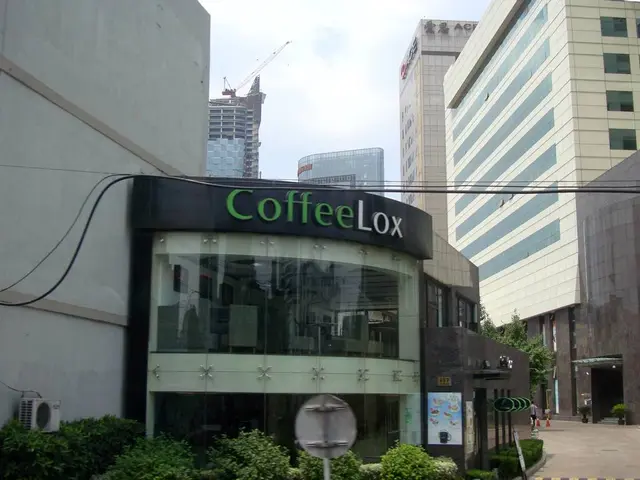Hit the Road with the Low-Down on Separating Toilets for Your Van Life!
Operating Mechanism of a Dry Toilet:
The allure of the open road and the freedom of explores distant lands - that's van life! Whether it's lost in a book at sunset, lounging solo or adventuring as a pair, van life is a fast-growing trend. But as enchanting as van life might be, the practicalities of everyday life arise, such as handling necessities on the move. With budgets to watch, a cost-effective and efficient solution is essential. Enter the dry toilet - your new best friend on the road! This comprehensive guide explains how these popular camper WCs operate!
Understanding a Dry Toilet
A dry toilet, or separating toilet, is a waterless toilet where solids are collected in a designated container and separated from urine. These are a go-to option in places without access to sewage systems and offer a scent-free, cheap, and eco-friendly alternative to chemical toilets. The solid waste can be composted and used as a fertilizer, helping conserve water and reduce the burden on sewage treatment plants and landfills. You'll be doing your part to protect the environment and feel fantastic about it!
Pro Tip: Wondering which mobile toilet suits your needs best? Get the scoop here: "Camper Toilet: The (Un)pleasant Journey on Wheels"
Dry Toilet Construction
The classic dry toilet comprises three core components: the separating insert, the solid waste container, and the urine canister. Accessories like compostable bags and drying materials for solids will help set you up for van life success. Here's a rundown of the toilet's parts:
(1) Separating Insert
The separating insert's function is to split solids from urine. After testing several prototypes, we perfected the design. For cleaning, simply remove the separating insert from the box and give it a good rinse. Opt for an eco-friendly cleaning product.
(2) Solid Waste Container
This container holds the waste generated and requires the use of a bag that must be disposed of and replaced regularly. To eliminate odors and absorb moisture, add drying materials to the waste. The litter is absorbent and the mixture of waste and litter are simpler to compost.
Regular cleaning keeps the solid waste container hygienic. As with the separating insert, we recommend using an eco-friendly cleanser for this task. Once the composting process is complete, you can use the soil on a bed.
(3) Urine Canister
The urine canister is the final essential component of the dry toilet. As the name suggests, urine is stored separately from the solids. A dry toilet isn't designed to store urine for extended periods; empty it every two to three days to prevent unpleasant odors.
Pro Tip: Diluted 1:10 with water, the urine from the canister can be used for watering your garden!
Now let's break down how the separating toilet actually works and what precautions to keep in mind while using it.
Dry Toilet: Behind the Scenes
User-friendly models like the BOXIO toilet operate without chemicals, water, or fuss. Here's a step-by-step guide:
1. Buy
Grab the BOXIO Toilet online, delivered complete with all essential components.
2. Set Up
Assemble the BOXIO Toilet using its three primary components: the separating insert, the solids container, and the urine canister. We've got you covered with a helpful video tutorial!
3. Use
Initially, fold up the separating insert and line the solids container with a tear-resistant, compostable bag. Add some drying materials to the container. Ensure the lid of the urine canister is unfastened before use. The liquid and solid waste are separated by the separating insert and collected in separate containers, minimizing odors and enabling targeted disposal.
4. Waste Disposal
Waste falls into either the solids container or the urine canister.
Warning: Always dispose of solid and urine waste properly to prevent pollution. This has led to complaints from neighbors and bans from authorities in the past.
5. Clean Up
After disposing of waste, thoroughly clean the toilet to prevent odors and ensure good hygiene. Clean all parts with an eco-friendly cleaner such as BOXIO-Clean.
boxio + Toilet: The Environmentally Friendly Option
- Made in Germany
- Offers excellent value for money
- Space-saving solution
- Box and separating insert made from recycled materials
- Box and separating insert in Euro format (40x30)
- Smooth surfaces and easy-to-clean plastic
- Comfortable separating insert
Women's Concerns with Dry Toilets
Are there potential challenges for women when using separating toilets?
Yes, at first there may be some hurdles, especially if you've never used a dry toilet before. It may take some practice for everything to go as planned, even during your period. Rest assured that these initial difficulties can be easily overcome!
- Aiming: It may take some practice for urine to land in the canister and solid waste in the container behind it. If something goes awry despite best efforts, don't worry.
- Period Management: Use your menstrual cup while on the road without hassle. Empty it into the rear container of the separating toilet.
- Disposable Products: Tampons or pads can be disposed of directly in the rear container of the toilet or in a separate waste container.[1]
By using the separating toilet when on your period, you'll enjoy a private, stress-free space to manage your needs without resorting to a public bathroom.
[product_metaobject_2]
Pro Tip: Dry toilets are often a lifesaver for children, too. Check out our article for more on this: "Portable Potty: How to Avoid Mishaps on the Go!"
Can a Separating Toilet also be used for Diarrhea?
Let's tackle an unpleasant but important topic: Separating toilet + diarrhea: Does it work?
If you've got diarrhea, you can still use your separating toilet without issue. However, there are additional measures you should take:
- Add More Drying Materials: Diarrhea necessitates adding extra drying materials to the solids container, which helps to absorb liquid.
- Change the Bag Frequently: If diarrhea is present, change the bag in the solids container more often to maintain good hygiene and reduce odors.
- Use a Separate Solids Container: If diarrhea is due to an illness, use a separate solids container to prevent the spread of pathogens.
Separating Toilet: Final Thoughts
In conclusion, separating toilets present an alternative, resource-saving solution for toilets without water flushing in the context of van life. This option is:
- Efficient and cost-effective
- Odorless and less wasteful
- User-friendly and easy to use
- Eco-friendly with compostable waste disposal
Regardless of a few initial adjustments during menstruation or diarrhea, separating toilets afford a versatile, sustainable, and practical option for everyday camping life. [product_metaobject_1]
FAQs:
How does a separating toilet work?
The separating toilet works by separating solid and liquid waste into distinct containers. Solid waste is contained and aided in the decomposition process with drying materials, while urine is collected separately.
How to use a separating toilet?
Here's a quick rundown on how to use it: 1️⃣ Sit on the seat and proceed as you would with a regular toilet. 2️⃣ Dispose of toilet paper in the solids container or in a separate container. 3️⃣ Cover solid waste with drying materials.
Where does urine go in a separating toilet?
The urine from a separating toilet is usually directed into a canister. This canister is located directly below the toilet opening in the case of the BOXIO toilet. Once full, it can be emptied in a public toilet.
Where does toilet paper go in a separating toilet?
Dispose of toilet paper in the solids container. Any ordinary toilet paper is suitable for use with the separating toilet. Simply cover the solid waste with drying materials once you're done.
Can a dry toilet also be used on a campsite?
Even dry toilets work on a campsite without water. This system is a conservation-minded choice for sites with limited water access or in nature reserves.
Can a dry toilet be used in a motorhome?
A dry toilet in a motorhome functions similarly to those in vans. Waste is separated and aided in decomposition via drying materials, and the components are easy to empty and clean.
The dry toilet, a user-friendly and eco-friendly option, is not just for van life but also suits other home-and-garden settings, offering a waterless lifestyle solution. This versatile gadget, composed of three core components (the separating insert, the solid waste container, and the urine canister), allows for cost-effective and minimalist living, even with gadgets like cameras and smartphones in tow. For those aiming to pair technology with a sustainable lifestyle, the dry toilet is a perfect addition. Additionally, the dry toilet can be easily integrated into a home-and-garden setting, making it a smart investment for those embracing a lifestyle focusing on technology, gadgets, and a greener and more cost-effective home.








